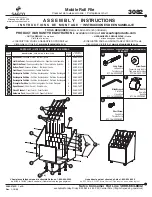Lexicon
LXP-15 II Owner's Manual
4-2
When a sound is reflected from walls and other surfaces, it loses some of its high
frequency content. If the surface is soft, or padded, such as a curtain or rug, more
high frequency content will be lost than if the surface is hard like tile or paneling.
Harder surfaces give rise to more reverberation; they are more “live”.
True echo occurs when a sound bounces off an acoustically hard surface; its
return is heard as a distinct repetition of the original sound. When synthesizing
an echo, the level and the high frequency content of the delayed sound, relative
to the original sound in the output mix, gives audible clues as to the hardness of
the reflecting surface(s). The intial delay time determines the impression of the
relative distance between the sound source, the imaginary reflecting surface,
and the listening position. Long delay times provide a very distinct repetition of
the source. Recirculation of the delayed sound (feedback) provides multiple
repetitions, and suggests two or more reflective surfaces that are bouncing the
sound back and forth.
An echo of around one-tenth of a second (100 milliseconds) delay time can be
heard as a distinct repetition of the original, but is so close that it is heard more
as a rhythmic enhancement rather than as a separate sound. A repeat of this
type is commonly called a “slap echo”. Often, the delay time is carefully adjusted
so that a simple relationship exists between the tempo of the music and the delay
time. On drums, the slap is often positioned on the opposite side of the stereo
field from the original sound. Careful use of slap echoes can increase the
rhythmic density and spatial interest of a musical arrangement. The "Tempo"
patch source of the LXP-15 II can be used to automatically synchronize slap
rhythms to a wide range of MIDI tempos.
Ambient echo effects simulate sound reflections from room surfaces — with
random reflections, a gradual decay of overall level, and a gradual narrowing of
the bandwidth. If the reflected sound continues to bounce back and forth
between surfaces, it provides a long decaying “tail”. To produce this effect, use
30-100ms of delay, in conjunction with feedback. Experiment with Hi and Lo cut
filters to simulate different absorption characteristics of the reflecting surfaces
(and of the air between them). To further enhance diffusion, try very small
amounts of LFO modulation of delay time at a slow rate.
Delay settings can be varied to create larger or smaller spaces. The longer the
delay times, the larger the space. Variation in the amount of feedback corre-
sponds to the hardness of the imaginary reflecting surfaces, and use of rolloff
can simulate the effects of air absorption on the high end of the sonic spectrum.
Plate effects were originally generated by large, thin sheets of metal suspended
upright under tension on springs. Transducers attached to the metal plate would
transmit a signal which would, in turn, vibrate the plate. Because the plate
provided a denser medium than air, sounds broadcast through it would seem to
be occurring in a large open space. Synthesized plate effects mimic the sound
of metal plates, with high initial diffusion and a relatively bright, colored sound.
They are designed to be heard as part of the music, mellowing and thickening
the initial sound itself. The plate sound is what most people used to associate
with the term “reverb”, and it is useful for all popular music, particularly
percussion. The LXP-15 II has a Plate algorithm dedicated to these effects.
Reflections
Slap Echoes
Ambient echo
Echo
Plates
Summary of Contents for LXP-15 II
Page 1: ...LXP 15 II Multi Effects Processor Owner s Manual...
Page 4: ...LXP 15 II Multi Effects Processor Owner s Manual...
Page 16: ...Lexicon LXP 15 II Owner s Manual 1 10...
Page 71: ...Lexicon LXP 15 II Owner s Manual 5 10...
Page 89: ...Lexicon LXP 15 II Owner s Manual 7 14...
Page 93: ...Lexicon LXP 15 II Owner s Manual 8 4...


















